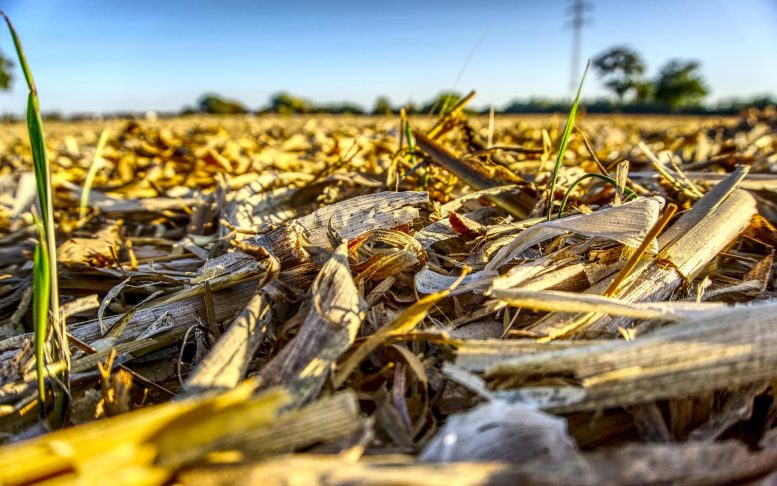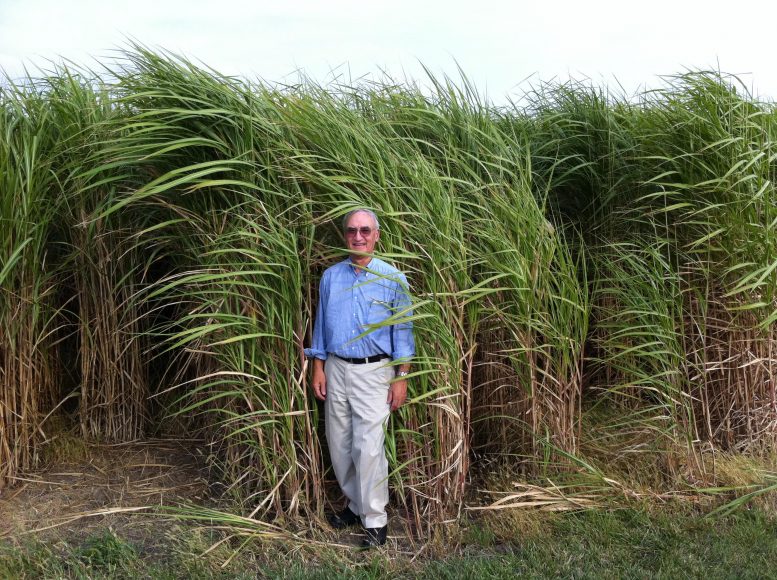
In a new paper, researchers present a method to more efficiently produce biofuels from woody plant materials such as corn residues and some grasses. Credit: Markus Distelrath/Pixabay
The new system streamlines the process of fermenting plant sugar to fuel by helping yeast survive industrial toxins.
More corn is grown in the United States than any other crop, but we only use a small part of the plant for food and fuel production; once people have harvested the kernels, the inedible leaves, stalks and cobs are left over. If this plant matter, called corn stover, could be efficiently fermented into ethanol the way corn kernels are, stover could be a large-scale, renewable source of fuel.
“Stover is produced in huge amounts, on the scale of petroleum,” said Whitehead Institute Member and Massachusetts Institute of Technology (MIT) biology professor Gerald Fink. “But there are enormous technical challenges to using them cheaply to create biofuels and other important chemicals.”
And so, year after year, most of the woody corn material is left in the fields to rot.
Now, a new study from Fink and MIT chemical engineering professor Gregory Stephanopolous led by MIT postdoctoral researcher Felix Lam offers a way to more efficiently harness this underutilized fuel source. By changing the growth medium conditions surrounding the common yeast model, baker’s yeast Saccharomyces cerevisiae, and adding a gene for a toxin-busting enzyme, they were able to use the yeast to create ethanol and plastics from the woody corn material at near the same efficiency as typical ethanol sources such as corn kernels.
Sugarcoating the issue
For years, the biofuels industry has relied on microorganisms such as yeast to convert the sugars glucose, fructose, and sucrose in corn kernels to ethanol, which is then mixed in with traditional gasoline to fuel our cars.
Corn stover and other similar materials are full of sugars as well, in the form of a molecule called cellulose. While these sugars can be converted to biofuels too, it’s more difficult since the plants hold onto them tightly, binding the cellulose molecules together in chains and wrapping them in fibrous molecules called lignins. Breaking down these tough casings and disassembling the sugar chains results in a chemical mixture that is challenging for traditional fermentation microorganisms to digest.

Whitehead Institute Member Gerald Fink standing in front of a field of the grass Miscanthus giganteus, which is another potential source of cellulose that could be converted to ethanol. Credit: Photo courtesy of Felix Lam
To help the organisms along, workers in ethanol production plants pretreat high-cellulose material with an acidic solution to break down these complex molecules so yeast can ferment them. A side effect of this treatment, however, is the production of molecules called aldehydes, which are toxic to yeast. Researchers have explored different ways to reduce the toxicity of the aldehydes in the past, but solutions were limited considering that the whole process needs to cost close to nothing. “This is to make ethanol, which is literally something that we burn,” Lam said. “It has to be dirt cheap.”
Faced with this economic and scientific problem, industries have cut back on creating ethanol from cellulose-rich materials. “These toxins are one of the biggest limitations to producing biofuels at a low cost.” said Gregory Stephanopoulos, who is the Willard Henry Dow Professor of Chemical Engineering at MIT.
Lending yeast a helping hand
To tackle the toxin problem, the researchers decided to focus on the aldehydes produced when acid is added to break down tough molecules. “We don’t know the exact mechanism by which aldehydes attack microbes, so then the question was, if we don’t really know what it attacks, how do we solve the problem?” Lam said. “So we decided to chemically convert these aldehydes into alcohol forms.”
The team began looking for genes that specialized in converting aldehydes to alcohols, and landed on a gene called GRE2. They optimized the gene to make it more efficient through a process called directed evolution, and then introduced it into the yeast typically used for ethanol fermentation, Saccharomyces cerevisiae. When the yeast cells with the evolved GRE2 gene encountered aldehydes, they were able to convert them into alcohols by tacking on extra hydrogen atoms.
The resultant high levels of ethanol and other alcohols produced from the cellulose might have posed a problem in the past, but at this point Lam’s past research came into play. In a 2015 paper from Lam, Stephanopoulos and Fink, the researchers developed a system to make yeast more tolerant to a wide range of alcohols, in order to produce greater volumes of the fuel from less yeast. That system involved measuring and adjusting the pH and potassium levels in the yeast’s growth media, which chemically stabilized the cell membrane.
By combining this method with their newly modified yeast, “we essentially channeled the aldehyde problem into the alcohol problem, which we had worked on before,” Lam said. “We changed and detoxified the aldehydes into a form that we knew how to handle.”
When they tested the system, the researchers were able to efficiently make ethanol and even plastic precursors from corn stover, miscanthus and other types of plant matter. “We were able to produce a high volume of ethanol per unit of material using our system,” Fink said. “That shows that there’s great potential for this to be a cost-effective solution to the chemical and economic issues that arise when creating fuel from cellulose-rich plant materials.”
Scaling up
Alternative fuel sources often face challenges when it comes to implementing them on a nationwide scale; electric cars, for example, require a nationwide charging infrastructure in order to be a feasible alternative to gas vehicles.
An essential feature of the researchers’ new system is the fact that the infrastructure is already in place; ethanol and other liquid biofuels are compatible with existing gasoline vehicles so require little to no change in the automotive fleet or consumer fueling habits. “Right now [the US produces around] 15 billion gallons of ethanol per year, so it’s on a massive scale,” he said. “That means there are billions of dollars and many decades worth of infrastructure. If you can plug into that, you can get to market much faster.”
And corn stover is just one of many sources of high-cellulose material. Other plants, such as wheat straw and miscanthus, also known as silvergrass, can be grown extremely cheaply. “Right now the main source of cellulose in this country is corn stover,” Lam said. “But if there’s demand for cellulose because you can now make all these petroleum-based chemicals in a sustainable fashion, then hopefully farmers will start planting miscanthus, and all these super dense straws.”
In the future, the researchers hope to investigate the potential of modifying yeasts with these anti-toxin genes to create diverse types of biofuels such as diesel that can be used in typical fuel-combusting engines. “If we can [use this system for other fuel types], I think that would go a huge way toward addressing sectors such as ships and heavy machinery that continue to pollute because they have no other electric or non-emitting solution,” Lam said.
Reference: “Engineered yeast tolerance enables efficient production from toxified lignocellulosic feedstocks” by Felix H. Lam, Burcu Turanli-Yildiz, Dany Liu, Michael G. Resch, Gerald R. Fink and Gregory Stephanopoulos, 25 June 2021, Science Advances.
DOI: 10.1126/sciadv.abf7613









“…most of the woody corn material is left in the fields to rot.” This doesn’t mean it is being wasted or discarded, it means it is returning nutrients to the soil which is good farming practice. Harvesting large quantities of the material will necessitate added fertilizers. This is a closed system – push it down in one spot and it sticks up somewhere else.